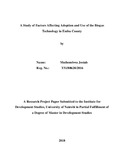| dc.description.abstract | Biogas was first introduced in Kenya in 1957. The initial objective was to generate bio-slurry which was used an organic fertilizer for large-scale coffee farmers. Despite efforts to promote the adoption of biogas through the 1980s, the rate of adoption and use remained low. In May 2007, the Kenya Biogas Task Force was formed to implement the National Biogas Energy Program. Despite the market potential, biogas related benefits and energy needs in the households; the adoption of biogas technology still remains low. The study sought to assess the level of adoption and use of biogas technology, the sustainability and efficiency of the bio-digesters installed under the KENDBIP program and to understand the factors that influence the adoption and use of biogas technology in Embu County. A conceptual framework developed on the basis of literature and theories on technology innovations and diffusion guided the analysis of the factors that influence the adoption and continued use of biogas technology.
The study used triangulation to guide the data collection exercise and the study population was selected through purposive sampling. The target was to reach households that had adopted biogas technology and were still using, those who had adopted and had stopped using and the ones that had never adopted. The aim of the focus in sample selection was to understand the factors that influenced adoption and use, why some adopters stopped using the technology after sometime and why some refused to adopt despite the numerous campaigns to promote the technology. Key informants were from the national government Ministry of Energy Ministry of Agriculture, and Livestock. From the Embu County Government: The Department of Energy and the Department of Agriculture and Livestock. Non-Governmental Organizations included: International Humanist Institute for Cooperation with Developing Countries (HIVOS), Netherlands Development Organization (SNV), Kenya National Farmers Association Program (KENFAP) and Simgas. The study adopted both qualitative and quantitative approaches in the process of data collection and analysis.
The study findings showed that the factors that influenced the adoption and use of biogas technology in Embu County were: The initial cost of installation, the efficiency of the bio-digesters and the attitudes derived from the experience of the biogas users, the availability of other sources of energy at the household, the level of income and education, the type of occupation and promotion of the biogas technology. The satisfied users stated that biogas energy
provided a cheap and clean source of energy for cooking in the household. They also expressed desire to get a means to harvest the excess gas produced for commercial purposes. For the failed bio-digester users, they complained of the high installation cost incurred only for the technology to fail, lack of information beyond the cost of the bio-digesters and inaccessibility of personnel to offer repair services for the faulty bio-digesters. The study identified that there was minimal coordination between stakeholders. For instance, after the phasing out of the KENDBIP program, installation and promotion of biogas technology has been left to the private investors.
The study suggests the following recommendations for policy: The government should coordinate with the private investors to ensure that the bio-digesters meet the set standards to promote sustainability. Provision of credit facilities with flexible terms and conditions that target the vulnerable groups in the community, an inclusive training manual, and training and certification of the local technicians | en_US |



